NVIDIA GeForce GTX 770 Review: The $400 Fight
by Ryan Smith on May 30, 2013 9:00 AM ESTAlthough GTX 770 is already a very high clocked part for GK104, we still wanted to put it through its paces when it comes to overclocking. Of particular interest here is actually memory overclocking, as this is the first video card shipping with 7GHz GDDR5 standard. This will let us poke at things to see just how far both the RAM itself and NVIDIA’s memory controller can go.
Meanwhile the switch to GPU Boost 2.0 for GTX 770 is going to change the overclocking process somewhat compared to GTX 680 and GTX 670. Overvolting introduces marginally higher voltages and boost bins to play with, while on the other hand the removal of power targets in favor of TDP means that we only get 106% – an extra 14W – to play with in TDP limited scenarios. Thankfully as we’ve seen we’re generally not TDP limited on GTX 770 at stock, which means our effective headroom should be greater than that.
| GeForce GTX 770 Overclocking | ||||
| Stock | Overclocked | |||
| Core Clock | 1046MHz | 1146MHz | ||
| Boost Clock | 1085MHz | 1185MHz | ||
| Max Boost Clock | 1136MHz | 1241MHz | ||
| Memory Clock | 7GHz | 8GHz | ||
| Max Voltage | 1.2 | 1.212v | ||
We’re actually a bit surprised we were able to get another 100MHz out of the GPU itself. Even without the extra overvoltage boost bin, we’re still pushing 1200MHz+ on 1.2v, which is doing rather well for GK104. Of course this is only a 9% increase in the GPU clockspeed, which is going to pale in comparison to parts like GTX 670 and GTX 780, each of which can do 20%+ due to their lower clockspeeds. So there’s some overclocking headroom in GTX 770, but as to be expected it's not a lot.
More interesting however is the memory overclock. We’ve been able to put another 1GHz on 6GHz GTX 680 cards in the past, and with the 7GHz base GTX 770 we’ve been able to pull off a similar overclock, pushing our GTX 770 to an 8GHz memory clock. The fact that NVIDIA’s memory controller can pull this off is nothing short of impressive; we had expected there to be some headroom, but another 14% is beyond our expectations. At this clockspeed the GTX 770 has a full 256GB/sec of memory bandwidth, 33% more than both a stock GTX 680 and the 384-bit GTX 580. Of course we’ll see if GTX 770 can put that bandwidth to good use.
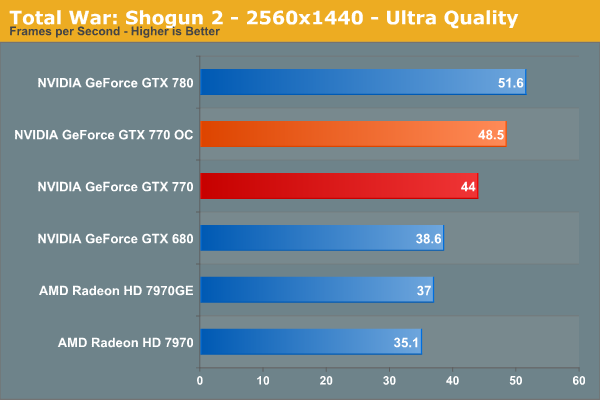
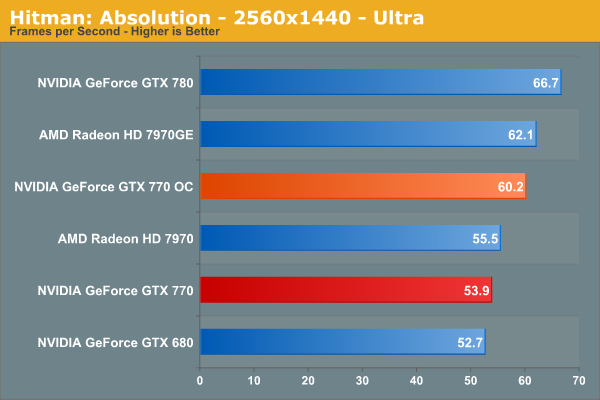
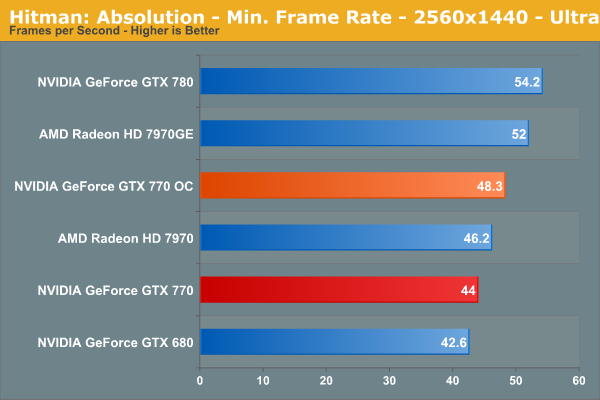
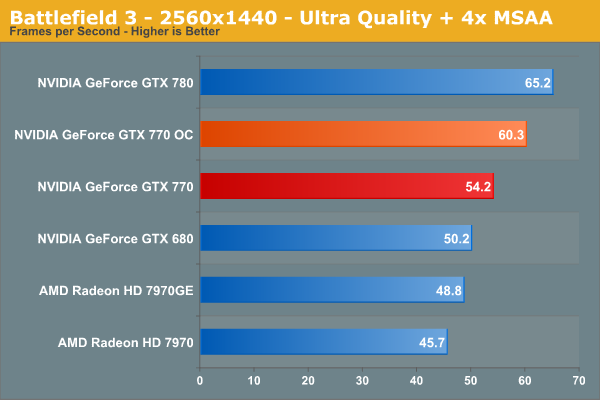
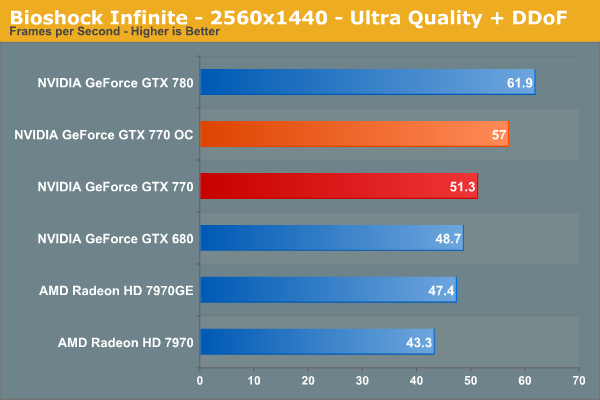
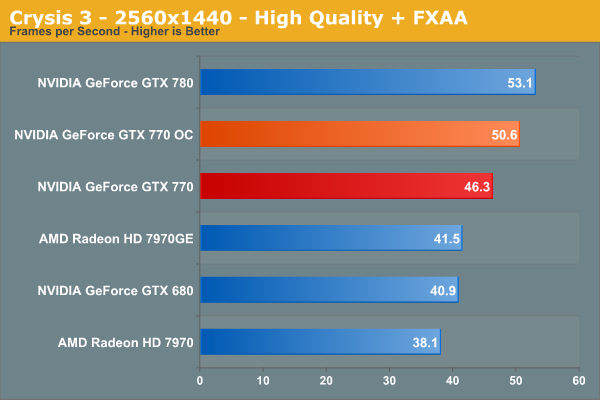
The end result of our overclocking efforts nets a very consistent 9%-12% increase in performance across our games. 9% is the upper bound for improvements due to GPU overclocking, so anything past that means we’re also benefitting from the extra memory bandwidth. We aren’t picking up a ton of performance from memory bandwidth as far as we can tell, but it does pay off and is worth pursuing, even with the GTX 770’s base memory clock of 7GHz.
Overall overclocking can help close the gap between the GTX 770 and 7970GE in some games, and extend it in others. But 10% won’t completely close the gap on the GTX 780; at best it can halve it. GTX 780’s stock performance is simply not attainable without the much more powerful GK110 GPU.
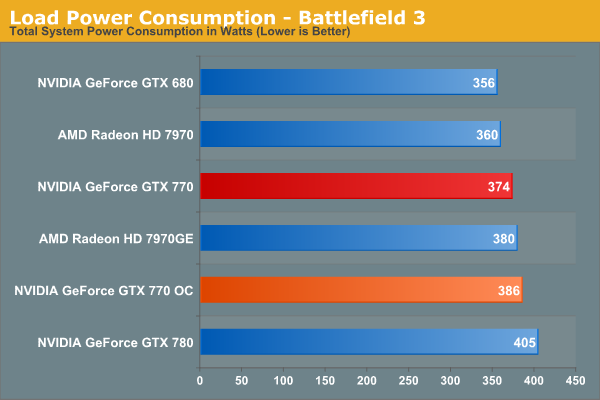
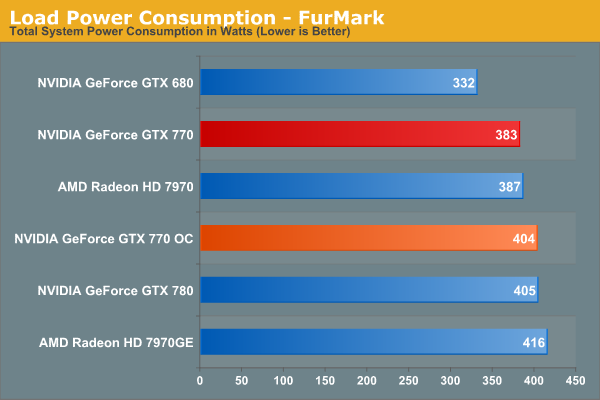
Moving on to power consumption, we can see that the 106% TDP limit keeps power usage from jumping up by too much. In Battlefield 3 this is a further 12W at the wall, and 21W at the wall with FurMark. In games this means our power usage at the wall is still below GTX 780, though we’ve equaled it under FurMark.
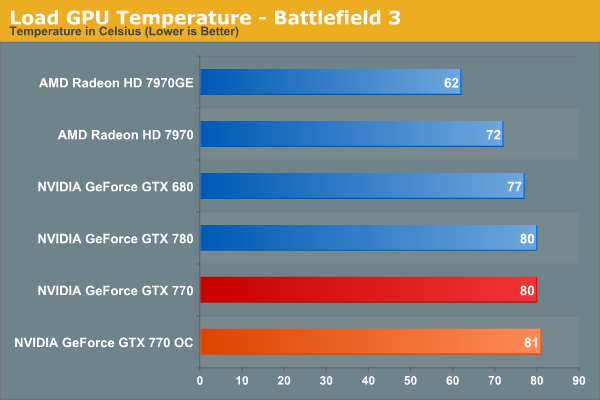
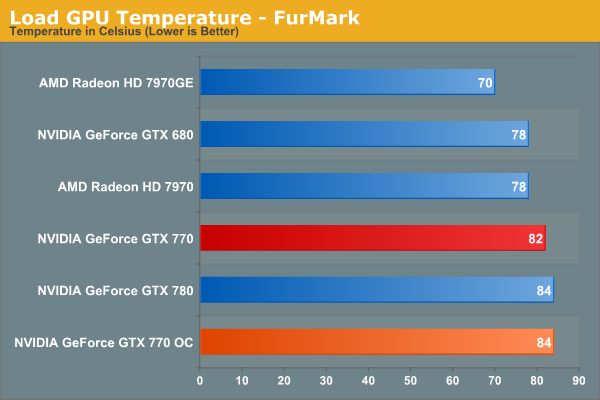
The fan curve for GTX 770 appears to be identical to that of GTX 780. Which is to say the fan significantly ramps up around 84C, keeping temperatures in the low-to-mid 80s even though GPU Boost 2.0 is allowed to go up to 95C.


Finally for fan noise, we see a small increase under Battlefield 3, and no change under FurMark. 1.5dB louder under Battlefield 3 puts noise levels on par with the GTX 780, sacrificing some of GTX 770’s abnormally quiet acoustics, but still keeping noise below the 50dB level. Or to put this another way, the performance gains for overclocking aren’t particularly high, but then again neither is the cost of overclocking in terms of noise.










117 Comments
View All Comments
khanov - Friday, May 31, 2013 - link
*sigh*You failed again.
khanov - Friday, May 31, 2013 - link
Sorry dude, that wasn't aimed at you. Anand your comments system has a mind of its own.If I reply to xyz I sort of expect my reply to be below xyz's comment and not inserted randomly in to the comments list.
chizow - Thursday, May 30, 2013 - link
Once again, a year late, but still a nice card. The updated cooler and higher memory clocks are impressive, but the max Boost clock was achievable on "FTW" type binned GTX 680s in the past.I guess this is Nvidia's "Gigahertz Edition", basically an overclocked SKU to bring parity in the performance midrange market.
Homeles - Thursday, May 30, 2013 - link
How in the world is this card a year late? Nvidia was still winning at this time, one year ago. Now they have not one, not two, but three single GPU cards that are on parity or are faster than the 7970 GE. Nvidia is in a far better position than they were with their GTX 500 series.chizow - Thursday, May 30, 2013 - link
Full GK104 should've been GTX 670 and below from the outset, as Nvidia initially planned. That's why it's a year late, at this price point anyways.Also, AMD reached parity with Nvidia's GTX 680 last year with the 7970GE launch in June/July, which then distanced itself by 5-10% with the Never Settle Drivers in Sept/Oct last year.
Now that the GTX 770 has launched and is ~10% faster than the 680, it again, reaches parity with the 7970GE.
JPForums - Thursday, May 30, 2013 - link
I thought the 104/114 series was historically reserved for the x60, while the 100/110 series was meant for the x70/x80 chips. Thus this new highend GK104 model should have been a 760Ti. GK110 should have maxed out at the 780 and the 770 should have been the paired down model. If they really had to have a Titan, it should have been a DPFP uncapped 780 (so they got that almost right).Of course the prices should have been the usual highend price points and not the massive price jumps they are currently pushing. Sure you can justify the price with the current performance relative to the previous generation, but if we always did that, the high end cards would get perpetually more expensive as the performance of each new generation of cards would justify a price hike over the previous generation. In reality, these prices are the unfortunate result of a lack of competition. Of course not all companies handle lack of competition the same way. nVidia has shown that, when uncontested, they will jack introductory prices into the stratosphere (8800 Ultra - $800-1000, $650 - GTX280, Titan/GTX780 - $1000/$650). Under normal competitive conditions, the top single GPU card from either nVidia or AMD/ATi of each generation comes in at $500. In similarly uncontested situations AMD/ATi has proven to be much less abusive to their customers (7970 - $550, 5870 - $400). Granted the relatively low price of the Dual GPU GTX295 probably kept the 5870s price in check until the GTX400 series launched, but at that point there was a significant difference in stability between single and dual GPU cards. Now I must mention, lest anyone gets the wrong idea, that AMD/ATi was probably only taking this route because marketshare/mindshare was more important to them than profit margins. Nonetheless, the facts remain.
chizow - Thursday, May 30, 2013 - link
I agree with virtually everything you said, although I never really had a problem with Nvidia jumping GK104 up a SKU to the x70 range. The performance was certainly there especially relative to last-gen performance and full GK104 also beat AMD's best offering at the time.The problem I had was Nvidia's decision to turn this 2nd tier ASIC into their flagship and subsequently, hold off on launching their true flagship ASIC a full year AND charge $1000 (and later, $650) for it.
All events predicated on the fact AMD launched 7970 at flagship prices when it really didn't deserve the asking price. Tahiti launch set the stage for Nvidia to not only undercut AMD pricing but to beat them in performance as well with only their 2nd tier chip.
JPForums - Thursday, May 30, 2013 - link
True, the 7970 could definitely be considered overpriced when it launched, but it was the undisputed performance champ until nVidia finally launched the GTX680 to bring back competition. Though, this begs the question, was the 7970 really this underperforming, or was the GK104 simply larger and faster (relatively speaking) than midrange chips in the past. Given that the GK104 die size is smaller than the GTS250, GTX460, GTX555 die sizes, I'd say larger is out. That said, they removed a lot of compute resources to get the gaming performance they were targeting, so faster might hold some weight.The 7000 series sudden proficiency in compute combined with the equally sudden removal of compute focus in the GTX600 series meant the 7970 would need to be far larger to maintain equivalent performance. Given the fact that Tahiti XT (352mm) was much closer to the size of GK104 (294mm) than GK110 (561mm), the 7970 should probably be considered a mid-weight. That is to say I can conclude that Tahiti XT was under performing (in games) AND GK104 was an overachiever. So the question becomes, is compute capabilities important enough to sacrifice gaming performance that a year ago likely would have clocked in closer to the GTX780 (GTX775 class?) for compute performance that in many cases exceeds Titan, but gaming performance roughly on par with a GTX680?
JlHADJOE - Friday, May 31, 2013 - link
IMO AMD's initial, higher price on the 7970 was justified. People forget that it was a much bigger chip than the 6970, with a 384-bit bus instead of 256. Any 384-bit part is effectively big, IMO. Same size as the 580, and now the Titan and 780.The fault here IMO goes right back to AMD's marketing division. If they hadn't stupidly went from 5870 to 6970, then people might have noticed that Tahiti was in fact a bigger part than its two immediate predecessors, and properly deserving of the 7900-series naming.
EJS1980 - Thursday, May 30, 2013 - link
Pretty much this /I\I
I